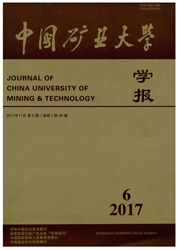

 中文摘要:
中文摘要:
通过大量的构件破型观测了混凝土中钢筋的表观锈蚀形态,基于电化学基本原理,对混凝土中钢筋的腐蚀电流分布进行了机理分析和试验验证.结果表明,混凝土内钢筋的锈蚀特征取决于钢筋内外表面的钝活化状态和他们之间形成的宏观腐蚀电流Ig.Ig的存在不仅加速了钢筋外表面的锈蚀,而且对钢筋内表面形成了阴极保护,从而使钢筋锈蚀呈现出靠近混凝土保护层的一侧锈蚀比较严重,而背向保护层的一侧则几乎没有发生锈蚀的特征.钢筋的腐蚀为微电池腐蚀和宏电池腐蚀并存,忽略其中任何一个都将使计算的腐蚀电流偏低.钢筋的总腐蚀电流等于活化区钢筋的微电池腐蚀电流Icorr2和Ig在活化区引起的阳极溶解电流的增大值(△IcorrA)之和.
 英文摘要:
英文摘要:
A large number of specimens of concrete containing corroded re-bar were examined by destroying them. The appearance of the re-bar was recorded. Fundamental electrochemical principles were used to analyze the corrosion currents along the circumference of the steel bar. The results were verified experimentally. The corrosion characteristics of the bar depend upon the state of the re-bar surface (activated or passivated) and the macro-corrosion current, Ig, that develops between the interior and the exterior of the bar. Ig both accelerates the corrosion of the outside surface of the bar and forms a cathodic protection to the inside of the bar. Thus corrosion occurs mainly on the side of the bar facing the concrete while no corrosion occurs on the side farthest from the concrete. Macrocell corrosion co-exists with microcell corrosion and the total corrosion could be understimated if either is overlooked. The total corrosion current is the sum of the microcell current, Icorr2, of the activated steel and the anodic dissolution current, IcorrA, caused by Ig.
 同期刊论文项目
同期刊论文项目
 同项目期刊论文
同项目期刊论文
 Field inspection on chloride ion-intrusion effect of seawater in dry-wet cycling zone of concrete st
Field inspection on chloride ion-intrusion effect of seawater in dry-wet cycling zone of concrete st Determination and application of the sharp degradation point of concrete under environmental actions
Determination and application of the sharp degradation point of concrete under environmental actions Spatial variability-based corrosion risk assessment and strategy of repair and maintenance for RC st
Spatial variability-based corrosion risk assessment and strategy of repair and maintenance for RC st 期刊信息
期刊信息
